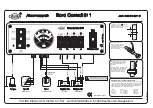
the radar sensor checked at a qualified spe-
cialist workshop. This also applies to colli-
sions at slow speeds where there is no visible
damage to the front of the vehicle.
i
Observe the "Important safety notes" sec-
tion (
Y
page 62).
BAS PLUS (Brake Assist System Plus)
G
WARNING
BAS PLUS cannot always clearly identify
objects and complex traffic situations. BAS
PLUS cannot intervene in these cases.
There is a risk of an accident. Always pay
careful attention to the traffic situation and be
ready to brake.
G
WARNING
BAS PLUS does not react:
R
to people or animals
R
to oncoming vehicles
R
to crossing traffic
R
to stationary obstacles
R
when cornering
As a result, BAS PLUS may not intervene in
critical situations. There is a risk of an acci-
dent. Always pay careful attention to the traf-
fic situation and be ready to brake.
BAS PLUS assists you in braking during haz-
ardous situations at speeds above 30 km/h
and uses the radar sensor system to evaluate
the traffic situation.
With the help of the radar sensor system, BAS
PLUS can detect obstacles that are in the
path of your vehicle for an extended period of
time.
Should you approach an obstacle and BAS
PLUS has detected a risk of collision, BAS
PLUS calculates the braking force necessary
to avoid a rear-end collision. Should you apply
the brakes forcefully, BAS PLUS will automat-
ically increase the braking force to a level
suitable for the traffic conditions.
X
Keep the brake pedal depressed until the
emergency braking situation is over.
ABS prevents the wheels from locking.
The brakes will work normally again if:
R
you release the brake pedal.
R
there is no longer any danger of a rear-end
collision.
R
no obstacle is detected in front of your
vehicle.
BAS PLUS is then deactivated.
Vehicles with PRE-SAFE
®
: if BAS PLUS
requires particularly high brake pressure, pre-
ventative passenger protection measures
(PRE-SAFE
®
) are deployed simultaneously.
Up to vehicle speeds of around 250 km/h,
BAS PLUS is capable of reacting to moving
objects that have already been recognised as
such at least once over the period of obser-
vation. BAS PLUS does not react to stationary
obstacles.
If BAS PLUS is not available due to a malfunc-
tion in the radar sensor system, the brake
system remains available with full brake
boosting effect and BAS.
In particular, the detection of obstacles can
be impaired if there is:
R
dirt on the sensors or anything else cover-
ing the sensors
R
snow or heavy rain
R
interference by other radar sources
R
the possibility of strong radar reflections,
for example, in multi-storey car parks
R
a narrow vehicle travelling in front, e.g. a
motorbike
R
a vehicle travelling in front on a different
line
Following damage to the front end of the vehi-
cle, have the configuration and operation of
the radar sensor checked at a qualified spe-
cialist workshop. This also applies to colli-
sions at slow speeds where there is no visible
damage to the front of the vehicle.
i
Observe the "Important safety notes" sec-
tion (
Y
page 62).
Driving safety systems
65
Safety
Z
Summary of Contents for B-Class 2011
Page 2: ......
Page 3: ......
Page 5: ......
Page 27: ...24 ...
Page 39: ...36 ...
Page 115: ...112 ...
Page 127: ...124 ...
Page 245: ...242 ...
Page 293: ...290 ...
Page 309: ...306 ...
Page 327: ...324 ...
Page 328: ......
Page 329: ......
















































